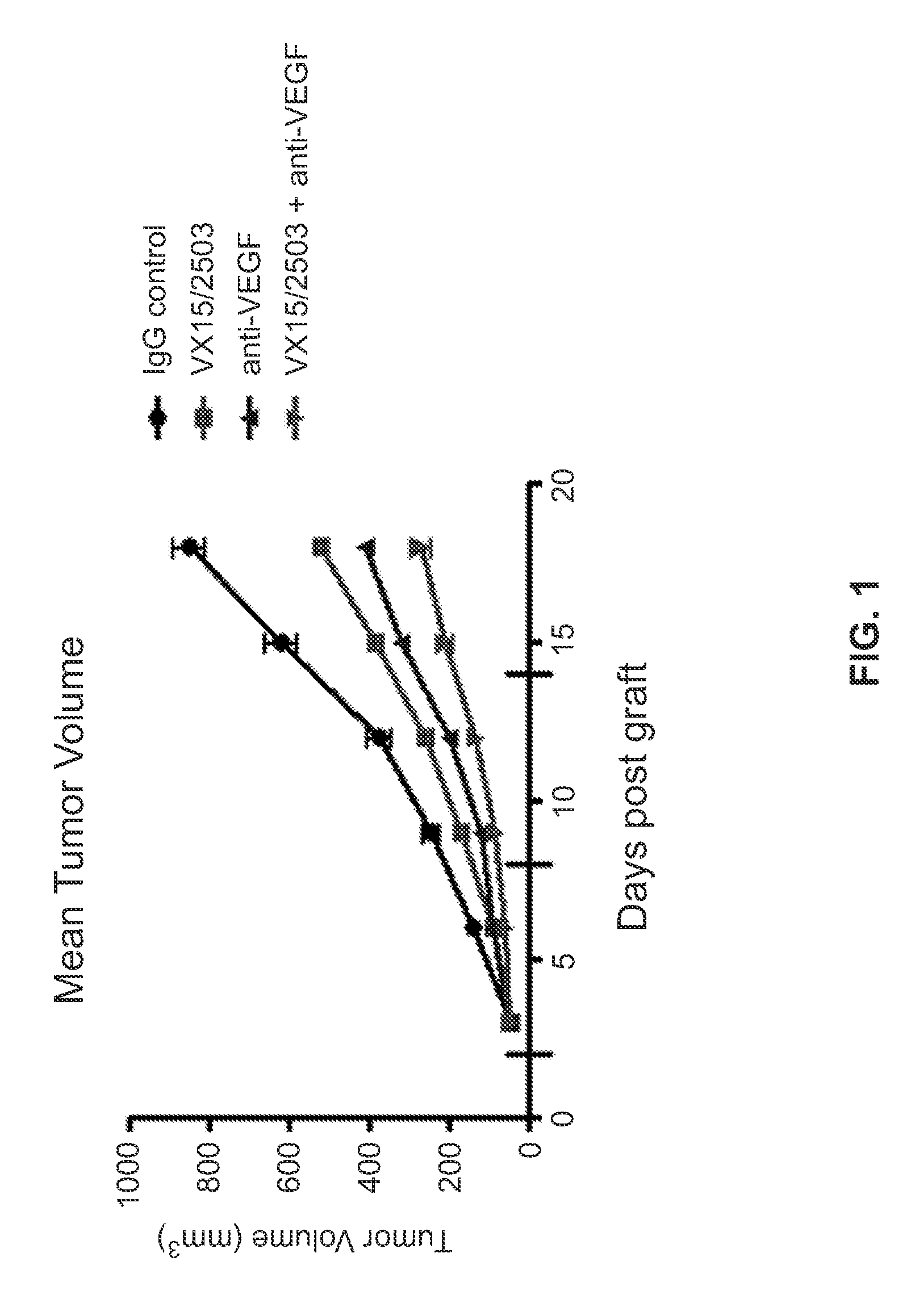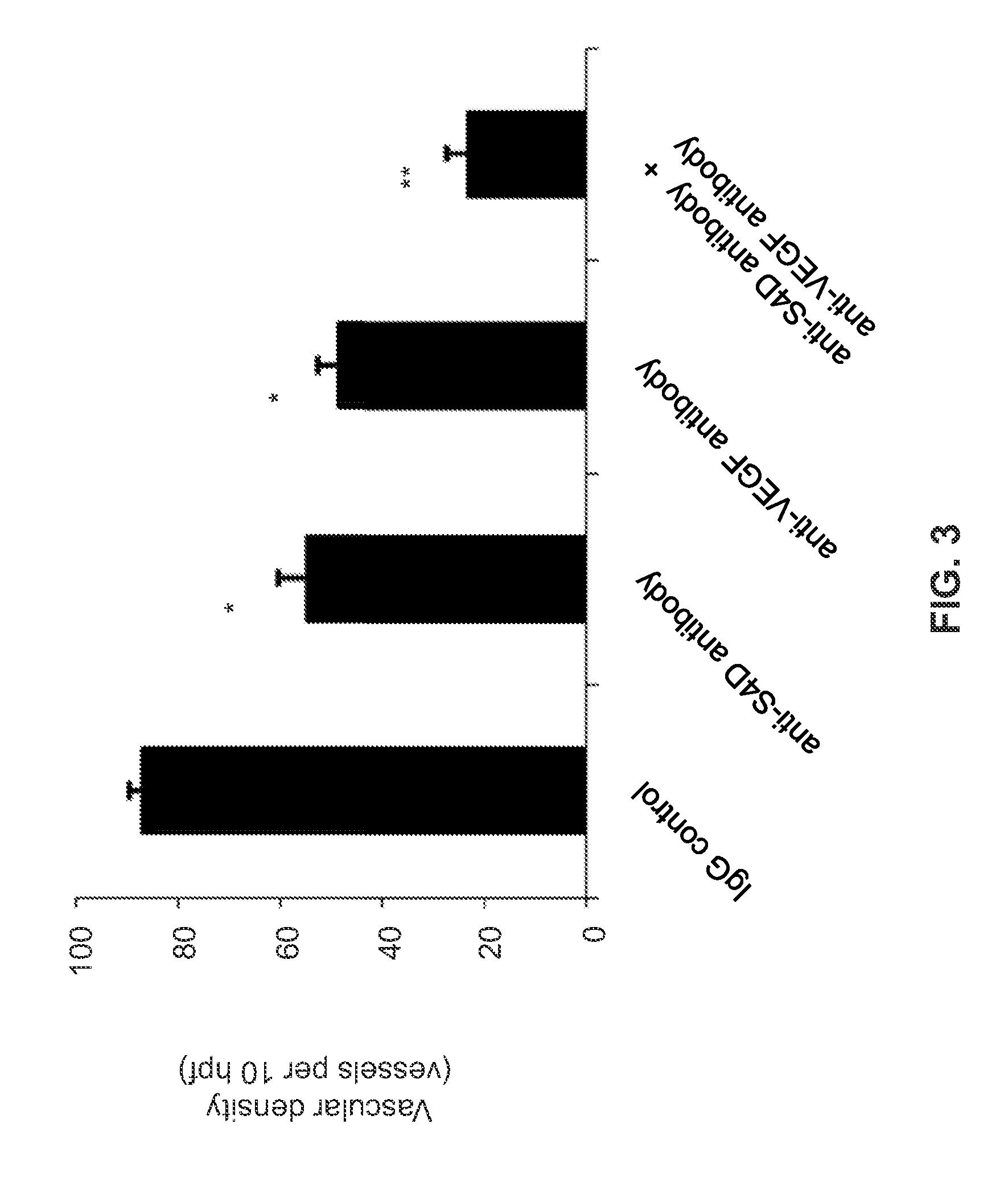Use of the combination of semaphorin-4D inhibitory molecules and VEGF inhibitory molecules to inhibit angiogenesis
a technology of vegf and semaphorin, which is applied in the field of using the combination of semaphorin4d inhibitory molecules and vegf inhibitory molecules to inhibit angiogenesis, can solve the problems of significant toxicity associated with clinical use of anti-vegf antibodies, and achieve the effect of inhibiting the interaction of vegf and angiogenesis
- Summary
- Abstract
- Description
- Claims
- Application Information
AI Technical Summary
Benefits of technology
Problems solved by technology
Method used
Image
Examples
example 1
Experimental Design
[0167]The basic experimental design is as follows. Tumor cells were implanted subcutaneously into both flanks of athymic nude mice. The tumor bearing nude mice were divided into four groups of seven mice each with each mouse having two tumors. The first group (control group) was treated with IgG isotype control MAb 2955. The second group was treated with anti-SEMA4D antibody VX15 / 2503. The third group was treated with an anti-VEGF antibody (Mouse IgG2A MAb 2931, which is a human VEGF MAb, Mouse IgG2A, Catalog #MAB2931; R&D Systems). The fourth group was treated with a combination of anti-SEMA4D antibody (VX15 / 2503) and anti-VEGF antibody (Mouse IgG2A MAb 2931). The treatment started two days post tumor graft. Mice were treated once a week with 1.0 mg (approximately 50 mg / kg) of monoclonal antibody via intraperitoneal (IP) injection for three weeks.
example 2
Primary Tumor Growth
[0168]Primary tumor growth was measured by calipers up to sacrifice, which measurements were used to calculate tumor volume. The animals treated with VX15 / 2503 alone showed a reduction in primary tumor volume at the time of sacrifice over the control animals, with the difference being statistically significant (P<0.0001). The animals treated with anti-VEGF (Mouse IgG2A MAb 2931) alone also showed a reduction in primary tumor volume at the time of sacrifice over the control animals, with the difference being statistically significant (P<0.0001). In addition, an additive effect on reduction of the tumor volume was seen when anti-SEMA4D antibody (VX15 / 2503) was used in combination with anti-VEGF antibody, with the difference being statistically significant (P<0.0001). Statistical analysis was conducted using Two-way Analysis of Variance (ANOVA), comparing tumor growth in each group to control antibody. T-test of final tumor volumes of resected tumors also resulted i...
example 3
Primary Tumor Vascular Density
[0169]The vascular density of the tumors was also measured. Vascular density was measured as vessels per 10 hpf (high power field). Treatment with either VX15 / 2503 or anti-VEGF (Mouse IgG2A MAb 2931) individually resulted in a decrease in vascular density, as compared to the control group. Treatment with anti-SEMA4D antibody (VX15 / 2503) in combination with anti-VEGF antibody resulted in a greater reduction in vascular density (**P<0.01), as compared to the control group as well as either VX15 / 2503 (*P<0.05) or anti-VEGF (*P<0.05) alone. The results are shown graphically in FIG. 3.
[0170]Many modifications and other embodiments of the inventions set forth herein will come to mind to one skilled in the art to which these inventions pertain having the benefit of the teachings presented in the foregoing descriptions and the associated drawings. Therefore, it is to be understood that the inventions are not to be limited to the specific embodiments disclosed a...
PUM
| Property | Measurement | Unit |
|---|---|---|
| vascular density | aaaaa | aaaaa |
| affinity | aaaaa | aaaaa |
| volume | aaaaa | aaaaa |
Abstract
Description
Claims
Application Information
 Login to View More
Login to View More - R&D
- Intellectual Property
- Life Sciences
- Materials
- Tech Scout
- Unparalleled Data Quality
- Higher Quality Content
- 60% Fewer Hallucinations
Browse by: Latest US Patents, China's latest patents, Technical Efficacy Thesaurus, Application Domain, Technology Topic, Popular Technical Reports.
© 2025 PatSnap. All rights reserved.Legal|Privacy policy|Modern Slavery Act Transparency Statement|Sitemap|About US| Contact US: help@patsnap.com



